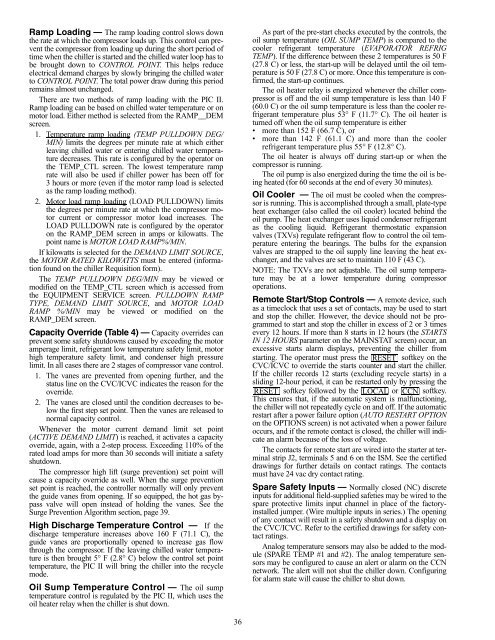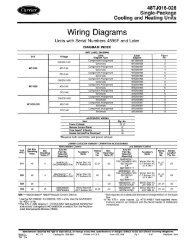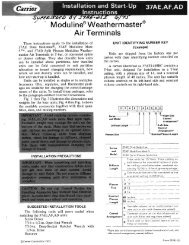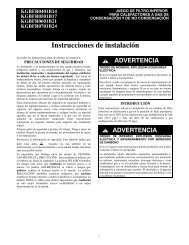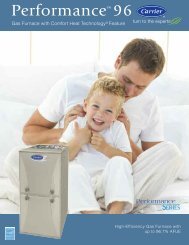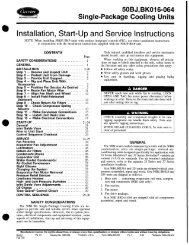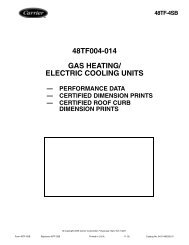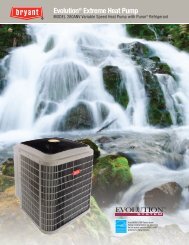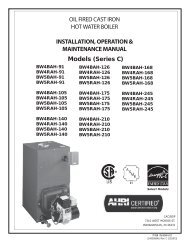Start-Up, Operation, and Maintenance Instructions
Start-Up, Operation, and Maintenance Instructions
Start-Up, Operation, and Maintenance Instructions
Create successful ePaper yourself
Turn your PDF publications into a flip-book with our unique Google optimized e-Paper software.
Ramp Loading — The ramp loading control slows down<br />
the rate at which the compressor loads up. This control can prevent<br />
the compressor from loading up during the short period of<br />
time when the chiller is started <strong>and</strong> the chilled water loop has to<br />
be brought down to CONTROL POINT. This helps reduce<br />
electrical dem<strong>and</strong> charges by slowly bringing the chilled water<br />
to CONTROL POINT. The total power draw during this period<br />
remains almost unchanged.<br />
There are two methods of ramp loading with the PIC II.<br />
Ramp loading can be based on chilled water temperature or on<br />
motor load. Either method is selected from the RAMP__DEM<br />
screen.<br />
1. Temperature ramp loading (TEMP PULLDOWN DEG/<br />
MIN) limits the degrees per minute rate at which either<br />
leaving chilled water or entering chilled water temperature<br />
decreases. This rate is configured by the operator on<br />
the TEMP_CTL screen. The lowest temperature ramp<br />
rate will also be used if chiller power has been off for<br />
3 hours or more (even if the motor ramp load is selected<br />
as the ramp loading method).<br />
2. Motor load ramp loading (LOAD PULLDOWN) limits<br />
the degrees per minute rate at which the compressor motor<br />
current or compressor motor load increases. The<br />
LOAD PULLDOWN rate is configured by the operator<br />
on the RAMP_DEM screen in amps or kilowatts. The<br />
point name is MOTOR LOAD RAMP%/MIN.<br />
If kilowatts is selected for the DEMAND LIMIT SOURCE,<br />
the MOTOR RATED KILOWATTS must be entered (information<br />
found on the chiller Requisition form).<br />
The TEMP PULLDOWN DEG/MIN may be viewed or<br />
modified on the TEMP_CTL screen which is accessed from<br />
the EQUIPMENT SERVICE screen. PULLDOWN RAMP<br />
TYPE, DEMAND LIMIT SOURCE, <strong>and</strong> MOTOR LOAD<br />
RAMP %/MIN may be viewed or modified on the<br />
RAMP_DEM screen.<br />
Capacity Override (Table 4) — Capacity overrides can<br />
prevent some safety shutdowns caused by exceeding the motor<br />
amperage limit, refrigerant low temperature safety limit, motor<br />
high temperature safety limit, <strong>and</strong> condenser high pressure<br />
limit. In all cases there are 2 stages of compressor vane control.<br />
1. The vanes are prevented from opening further, <strong>and</strong> the<br />
status line on the CVC/ICVC indicates the reason for the<br />
override.<br />
2. The vanes are closed until the condition decreases to below<br />
the first step set point. Then the vanes are released to<br />
normal capacity control.<br />
Whenever the motor current dem<strong>and</strong> limit set point<br />
(ACTIVE DEMAND LIMIT) is reached, it activates a capacity<br />
override, again, with a 2-step process. Exceeding 110% of the<br />
rated load amps for more than 30 seconds will initiate a safety<br />
shutdown.<br />
The compressor high lift (surge prevention) set point will<br />
cause a capacity override as well. When the surge prevention<br />
set point is reached, the controller normally will only prevent<br />
the guide vanes from opening. If so equipped, the hot gas bypass<br />
valve will open instead of holding the vanes. See the<br />
Surge Prevention Algorithm section, page 39.<br />
High Discharge Temperature Control — If the<br />
discharge temperature increases above 160 F (71.1 C), the<br />
guide vanes are proportionally opened to increase gas flow<br />
through the compressor. If the leaving chilled water temperature<br />
is then brought 5° F (2.8° C) below the control set point<br />
temperature, the PIC II will bring the chiller into the recycle<br />
mode.<br />
Oil Sump Temperature Control — The oil sump<br />
temperature control is regulated by the PIC II, which uses the<br />
oil heater relay when the chiller is shut down.<br />
36<br />
As part of the pre-start checks executed by the controls, the<br />
oil sump temperature (OIL SUMP TEMP) is compared to the<br />
cooler refrigerant temperature (EVAPORATOR REFRIG<br />
TEMP). If the difference between these 2 temperatures is 50 F<br />
(27.8 C) or less, the start-up will be delayed until the oil temperature<br />
is 50 F (27.8 C) or more. Once this temperature is confirmed,<br />
the start-up continues.<br />
The oil heater relay is energized whenever the chiller compressor<br />
is off <strong>and</strong> the oil sump temperature is less than 140 F<br />
(60.0 C) or the oil sump temperature is less than the cooler refrigerant<br />
temperature plus 53° F (11.7° C). The oil heater is<br />
turned off when the oil sump temperature is either<br />
more than 152 F (66.7 C), or<br />
more than 142 F (61.1 C) <strong>and</strong> more than the cooler<br />
refrigerant temperature plus 55° F (12.8° C).<br />
The oil heater is always off during start-up or when the<br />
compressor is running.<br />
The oil pump is also energized during the time the oil is being<br />
heated (for 60 seconds at the end of every 30 minutes).<br />
Oil Cooler — The oil must be cooled when the compressor<br />
is running. This is accomplished through a small, plate-type<br />
heat exchanger (also called the oil cooler) located behind the<br />
oil pump. The heat exchanger uses liquid condenser refrigerant<br />
as the cooling liquid. Refrigerant thermostatic expansion<br />
valves (TXVs) regulate refrigerant flow to control the oil temperature<br />
entering the bearings. The bulbs for the expansion<br />
valves are strapped to the oil supply line leaving the heat exchanger,<br />
<strong>and</strong> the valves are set to maintain 110 F (43 C).<br />
NOTE: The TXVs are not adjustable. The oil sump temperature<br />
may be at a lower temperature during compressor<br />
operations.<br />
Remote <strong>Start</strong>/Stop Controls — A remote device, such<br />
as a timeclock that uses a set of contacts, may be used to start<br />
<strong>and</strong> stop the chiller. However, the device should not be programmed<br />
to start <strong>and</strong> stop the chiller in excess of 2 or 3 times<br />
every 12 hours. If more than 8 starts in 12 hours (the STARTS<br />
IN 12 HOURS parameter on the MAINSTAT screen) occur, an<br />
excessive starts alarm displays, preventing the chiller from<br />
starting. The operator must press the RESET softkey on the<br />
CVC/ICVC to override the starts counter <strong>and</strong> start the chiller.<br />
If the chiller records 12 starts (excluding recycle starts) in a<br />
sliding 12-hour period, it can be restarted only by pressing the<br />
RESET softkey followed by the LOCAL or CCN<br />
softkey.<br />
This ensures that, if the automatic system is malfunctioning,<br />
the chiller will not repeatedly cycle on <strong>and</strong> off. If the automatic<br />
restart after a power failure option (AUTO RESTART OPTION<br />
on the OPTIONS screen) is not activated when a power failure<br />
occurs, <strong>and</strong> if the remote contact is closed, the chiller will indicate<br />
an alarm because of the loss of voltage.<br />
The contacts for remote start are wired into the starter at terminal<br />
strip J2, terminals 5 <strong>and</strong> 6 on the ISM. See the certified<br />
drawings for further details on contact ratings. The contacts<br />
must have 24 vac dry contact rating.<br />
Spare Safety Inputs — Normally closed (NC) discrete<br />
inputs for additional field-supplied safeties may be wired to the<br />
spare protective limits input channel in place of the factoryinstalled<br />
jumper. (Wire multiple inputs in series.) The opening<br />
of any contact will result in a safety shutdown <strong>and</strong> a display on<br />
the CVC/ICVC. Refer to the certified drawings for safety contact<br />
ratings.<br />
Analog temperature sensors may also be added to the module<br />
(SPARE TEMP #1 <strong>and</strong> #2). The analog temperature sensors<br />
may be configured to cause an alert or alarm on the CCN<br />
network. The alert will not shut the chiller down. Configuring<br />
for alarm state will cause the chiller to shut down.


